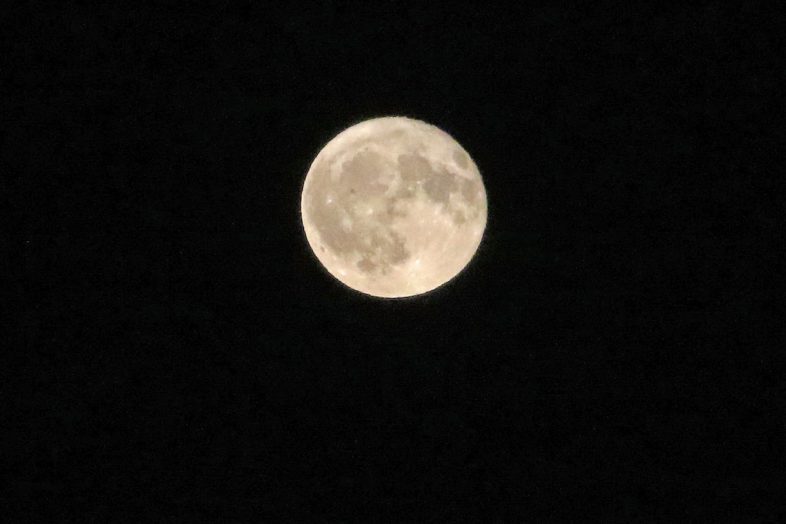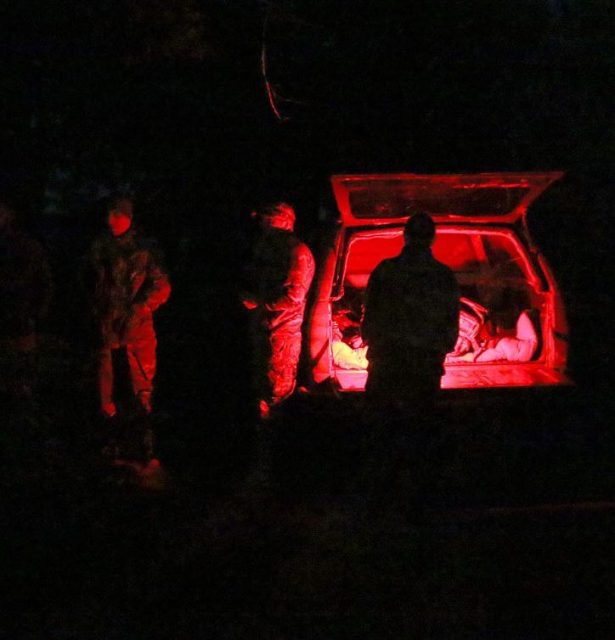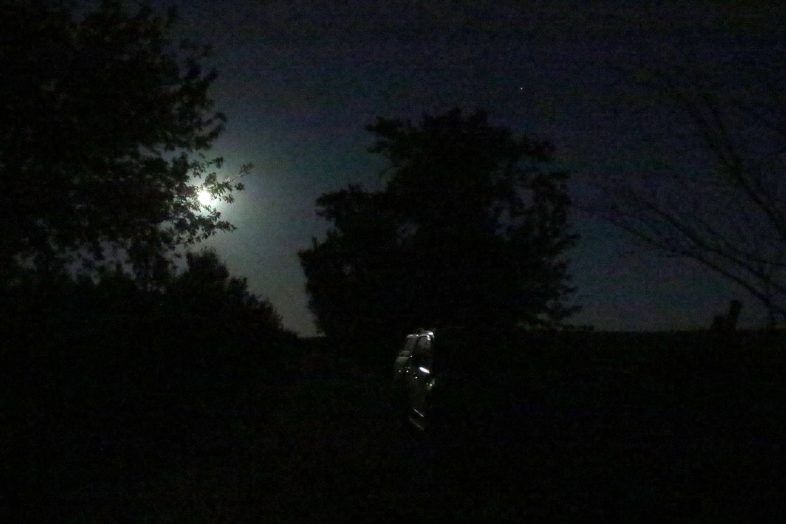They work at night, close to the front lines. While most operations on the front are conducted at night for greater effectiveness and safety, these soldiers have a unique mission: they hunt Shaheds.
Naturally, I couldn’t pass up the chance to join the hunt. Especially since the previous night had been particularly intense. The enemy had launched nine rockets of various types across Ukraine and carried out 27 UAV strikes. Given that mass attacks are rarely isolated events and typically continue the next night, I had the opportunity to witness firsthand how Ukrainian soldiers neutralise the Iranian-Russian drones.

Photo: Roman Malko
As night falls, the team heads to their positions. Russians typically launch drones under the cover of darkness to make it harder for our air defence, the Shahed hunters, to target them. Shooting these drones down at night is far more challenging than during the day. If a launch is detected early, they adjust their departure time, but it’s usually a nocturnal operation that can sometimes stretch into the morning.
“There were days,” reminisces Poltava, a fighter with the Ukrainian Volunteer Army (UVA) known by the call-sign Poltava, “when we finished work at eight in the morning. The store opens, we drink coffee, people pass by, and they can’t tell if we’re coming off shift or starting one. There were times we went out three or four times a night and times when Shaheds took off at nine in the morning.”
Each night is different for Shahed hunters. They might get a break by the second night, or their work could continue until five in the morning. However, downtime doesn’t necessarily mean relaxation. They could be called out again at any moment. The guys say they never truly relax and are always ready to work. They lie down on their beds, fully dressed, with everything packed in the car. If a mission comes in, they have just ten minutes to reach their positions and get ready. Working at night is undeniably more challenging than during the day, but for volunteers, motivation is the driving force that makes everything manageable.
The mobile group we’re joining comprises soldiers from the 3rd Separate Battalion “Volyn” of the UVA and territorial defence troops of the Armed Forces of Ukraine. They are equipped with several large-caliber machine guns, a thermal imager with a laser, and a tablet with a program for tracking Shahed movements. The group left earlier, so our first task is to locate them among numerous positions. This is no easy feat, given the darkness, the need for light discipline, and their constant mobility.
As we advance, online reports detail Shahed launches from Crimea towards Mykolaiv. Technically, this isn’t our designated area; these are primarily drones launched from Kuban. However, the situation remains unpredictable. Predicting the behaviour of these sophisticated machines is futile. They can alter their course abruptly, initiating anti-Shahed operations here. This is especially crucial now, as these Shaheds are significantly more intelligent than earlier versions. Equipped with advanced internals, they appear capable of detecting and evading threats, adapting their flight paths in response.
Recently, the team has noticed a change in the enemy’s tactics. Drones are now launched in smaller groups of three to four, whereas before, they came in swarms of eight to ten. Back then, they would use everything at their disposal to shoot down or at least damage as many as possible. “It doesn’t matter where we shoot it down; the main thing is it doesn’t reach its target,” they say.

Photo: Roman Malko
Near the front line, the challenge is that these drones fly at high altitudes, between six hundred to a thousand meters, at speeds of up to two hundred kilometres per hour to avoid being targeted by MANPADS. Only later do they descend to about 100-150 meters, weaving through valleys and riverbeds. Shooting them down at such high altitudes with a regular heavy machine gun is not easy. “The capabilities of our weapons for precise work are limited, but you always have to take the chance,” explains Poltava. “And sometimes a blind shot hits its mark. And it did…”
The local hunters have shot down quite a few drones. Just in June, around a dozen. “This week, four; last week, three in one day, and before that, two more. There has been a lot of activity in recent months because more mobile groups have joined, allowing us to spread out.”
Determining who shot down the drone isn’t straightforward. “We’re a friendly team here, and nobody’s keeping score,” they say. The credit for a fatal shot could go to anyone, but the entire process is crucial for the result. Multiple groups work simultaneously or sequentially on each drone. “Initially, let’s say it was coming straight at us; we engaged it, then it moved to another point and was finished off there. But near us, it already started changing its sound and behaviour, then continued for another 15 kilometres before crashing,” explains Poltava.
When the search team arrives at the crash site, they find parts like wings and tails; then the identification takes place. “The loaded part exploded during the fall. Everyone did great. Even if you see that you’re finishing it off, it doesn’t necessarily mean you brought it down. Everyone brought the drone down along its path.”
The rotation of hunters for drone missions often feels like a nocturnal picnic. Some monitor missile and drone flights on their gadgets, while others engage in casual conversations about anything or nothing at all. Some get hungry and eat sandwiches or sip tea, while others doze off, listen to music, or watch hares through thermal imagers. The hares have proliferated incredibly in these areas; in one field section, they counted nine. They don’t even flee if you shine a powerful spotlight on them. They sit calmly, risking becoming prey for the drone hunters. However, this time, the guys didn’t want to shoot hares. Running around the field at night to search for a wounded hare could be problematic if a target appears and they need to move to positions quickly.
Positions, in this case, are quite flexible. It all depends on the specific situation. Typically, a mobile group has several points marked on the map where they drive in, understanding the drone’s flight trajectory. They analyse the turn on the map, select a point closer to it, and choose the most effective spot to work. Hunters get all the necessary information from a tablet through a special application or via radio. However, there are always nuances. For example, during our watch, information came about a possible missile flyby over the area where we were. There wasn’t time to drive to the sighting point, so the guys prepared to work from their parking spot. But at the last moment, the target disappeared: neighbouring units shot down the missile, and there was no need to work after all.
Indeed, they were prepared to shoot down the missile with heavy machine guns. Effectiveness isn’t the primary concern; any chance to prevent civilian casualties is worth taking. In war, you seize every opportunity.
“Why haven’t there been drone attacks in our direction for so long?” I ask the hunters as midnight passes. “Isn’t this their usual corridor? Maybe the full moon is too bright?”

Photo: Roman Malko
“This is their well-trodden route,” the guys confirm. “They’ve flown this path before and will continue to do so. But there’s nothing interesting for them here tonight. The moon isn’t the reason. They’re likely targeting something significant elsewhere or trying to detect a big air defence system—not here. At most, we have an anti-aircraft gun. It’s too close to the front line; a Stinger missile or some other threat could reach us. They aim for areas with more substantial targets.”
A few days ago, the team took down an entire group of drones in this area, likely prompting the enemy to take a break and reassess. Increased scout activity in the night sky supports this. “But that won’t help them,” the guys say. “They change routes, and we change positions.”
Around two in the morning, we received the all-clear. This time, no drones flew out from Kuban, and it turned out the full moon wasn’t the reason. The previous night, after a mass Russian attack, Ukrainian Defence Forces destroyed the launch site in Yeysk, where the orcs send Shaheds across Ukraine. They also took out a massive drone warehouse and the operators who serviced them. Our front was quiet for a whole week, but then, unfortunately, the flights resumed. A fresh batch of deadly drones likely arrived from Iran, and now the Shahed hunters are back to work at night.

